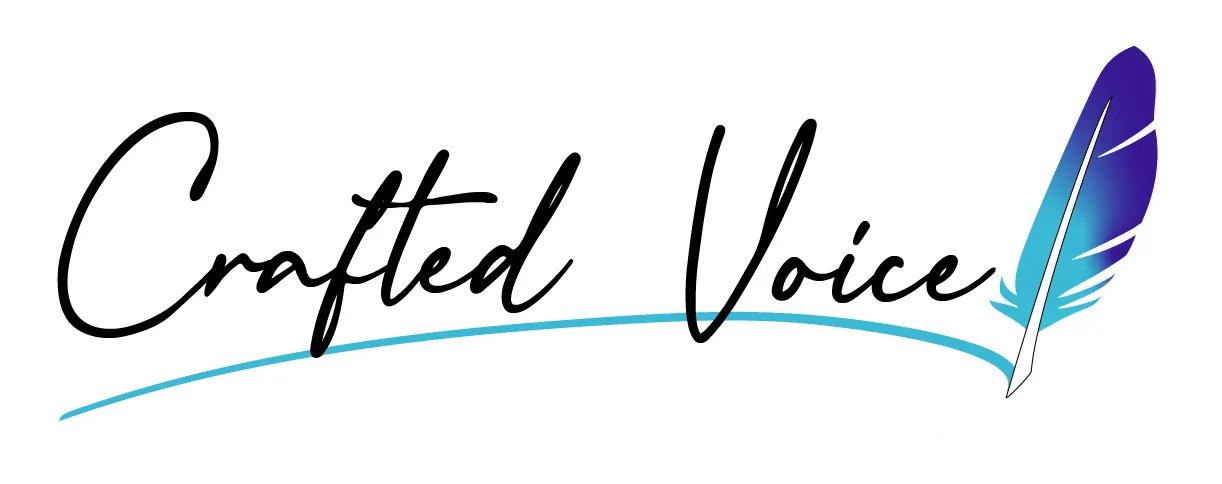Marketing Resources
Is your backpack packed with the marketing resources and supplies you need to be successful in business?
Remember back to when you were a kid and it was your first day of school…
…your excitement mixed with nervousness about having a new teacher and new classes; the sound of the squeaky school bus brakes when it stopped to pick you up; the smell of your school supplies.
Starting a new endeavor, whether it’s launching your business or experimenting with a new project or campaign, can bring about those same types of feelings and sensations: nervousness, excitement, and heightened senses knowing things are changing.
Is your backpack packed with the supplies you need to be successful in business?
It’s important to know what marketing tools for business you need to be efficient, resourceful, and successful. Just as you had a school supplies list to go shopping before the first day of school as a kid, you need a marketing tools and resources list for your business. Crafted Voice is happy to not only provide a starter list of possibilities, but to also be your guidance counselor, walking you through the steps you need to graduate to the next level of business success. This page is filled with everything you need to get started. And when you are ready, schedule a free consultation to get 1:1 expert advice and partnership on everything from strategy to brand voice to execution.
What are marketing resources?
Think of marketing resources as the tools you need in your backpack to prepare you to focus and run your business. What marketing resources you need vary depending on the age and size of your business, your industry, if you are service-oriented or product-oriented, if you are a B2B or B2C business, if you are locally, regionally, nationally, or globally focused…I’ll stop there because the list of variables is long.
While there are thousands of tools and resources available to you as a business owner, you want to be strategic about which you implement, when you implement them, and how much you are spending on them. Choosing the right platforms, softwares, frameworks, and management tools for your business will set you up for success in the long run, so take your time making the decisions up front. You’ll waste time and money implementing the wrong tools and switching to the better options later on.
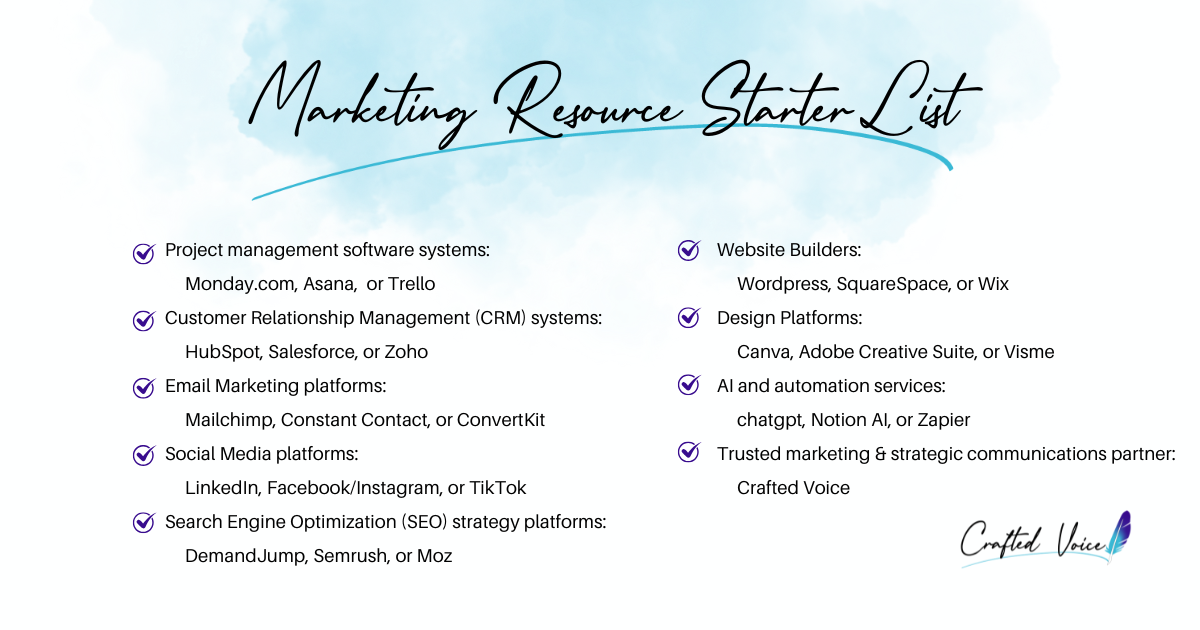
Here is a starter list of marketing resources to consider:
- Project management software systems, like Monday.com, Asana, and Trello.
- Customer Relationship Management (CRM) systems, such as HubSpot, Salesforce, and Zoho.
- Email Marketing platforms, such as Mailchimp, Constant Contact, and ConvertKit
- Social Media platforms, such as LinkedIn, Facebook, and TikTok.
- Search Engine Optimization (SEO) strategy platforms, like DemandJump, Semrush, and Moz.
- Website Builders, such as WordPress, SquareSpace, and Wix.
- Design Platforms, such as Canva, Adobe Creative Suite, and Visme.
- AI and automation services, such as chatgpt, Notion AI, and Zapier.
- A trusted marketing partner and/or strategic communications business coach, like Crafted Voice!
Remember, there are a lot of variables to consider when choosing the right resources. Take your time exploring and putting together a strategy before deciding which are right for you and your business.
Why are marketing resources important?
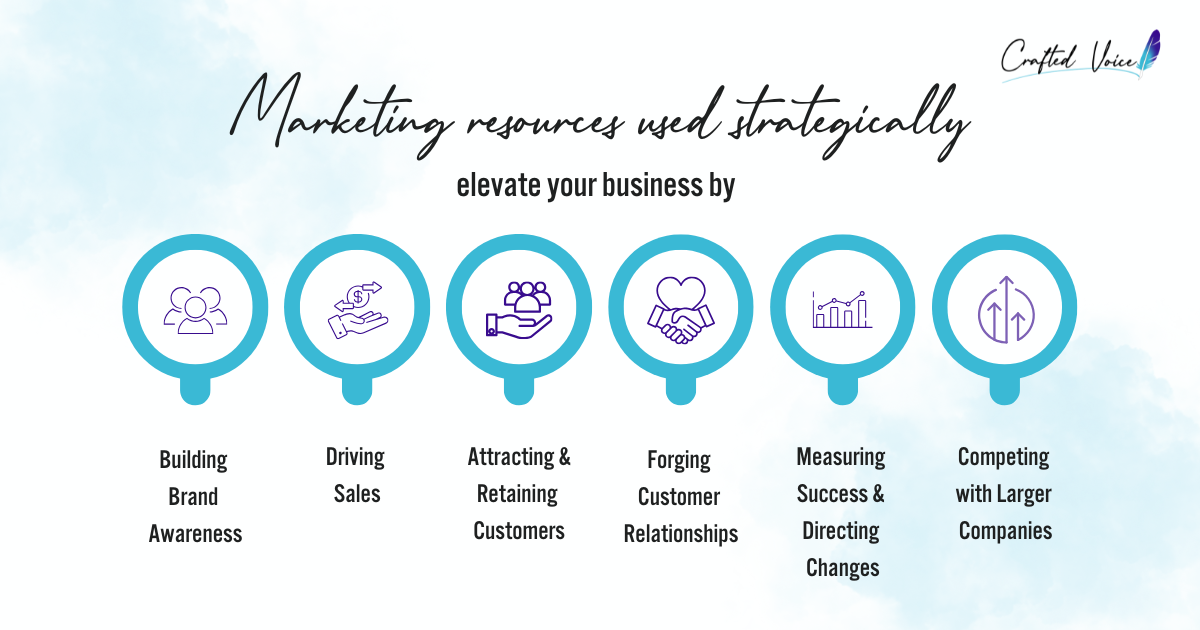
Kids can show up for the first day of school with nothing but their body and still be considered a student. With the proper school supplies in their backpack, however, they elevate their status from “a student” to “a student ready to learn and focus”. They are much more likely to be on the honor roll list and get a good report during parent-teacher conferences if they have, and are using, the right tools and resources.
In the same vein, you can certainly go about your business and marketing efforts without using any resources, but choosing the right tools for your workflow and budget will make the process much easier and more efficient, saving you time, money, and gray hair. Strategically using marketing resources elevates your business from “a business,” to “a business that customers want to do business with.”
They do this by:
- Building brand awareness
- Driving sales
- Attracting and retaining customers
- Forging customer relationships
- Measuring success and directing changes
- Competing with larger companies
Marketing resources are important because they drive growth, ensure sustainability, and help businesses like yours thrive in a competitive marketplace. Don’t make careless decisions about marketing resources that affect your business. Take your time, think strategically, and consult with a trusted strategic communications partner.
Strategic Communications & Marketing Coaching
Gain expert guidance and the data-driven insights you need to build a tailored communications strategy that spawns unstoppable business growth. With our coaching, you’ll have a trusted partner by your side, supporting you exactly where and when you need it.
What are the three types of resources in marketing?
There are three types of resources in marketing: owned media, earned media, and paid media.
Owned Media
Fully controlled by your business.
Earned Media
Publicity developed by others.
Paid Media
Paid for by your business.
Owned media includes any marketing resources that your business owns and fully controls: your website and social media accounts are the most obvious examples.
Think of earned media as publicity, or marketing resources that are developed by others. If customers are leaving reviews in a public place, that’s earned media. If a news outlet picks up a story about your business, that is also earned media.
Have you ever heard the phrase, “all publicity is good publicity”? This mindset believes all attention is good attention, even if it’s not for good reasons.
When it comes to marketing this is terrible advice, so please don’t take it. From tone-deaf ads to using sexism as click-bait, bad publicity is just that: bad publicity. You have a wonderful opportunity to build a strong reputable brand by earning positive media attention. What others are saying about your brand makes a huge difference for buyers who prioritize peer recommendations.
Paid media includes marketing resources that your business pays to put out into the world: Google Ads, billboards, boosting a social media post, or direct mailers. This type of media offers a quick way to get in front of your target audience, but it comes at a price and if the message isn’t resonating, can lead to wasted time and money.
If you want to hit all three types of marketing resources quickly, social media marketing resources often fall into all three categories. Your business can own its own page and post its own content, while also paying for ads, and receiving customer reviews and word-of-mouth sharing of posts.
There is much to learn and know about the importance of marketing for business owners and how to leverage certain strategies, frameworks, and resources for success. Sometimes, looking at the best marketing strategies used by companies can be a great way to start this process.
What are marketing materials?
Marketing materials are anything that you use to market your business, your services, and your products.
Digital marketing materials include websites, blogs, ebooks, search engine ads, your logo, and promotional videos (to name just a few).
Traditional marketing materials include billboards, print ads, mailers, brochures, signs, point of sale displays, and many more.
Choosing the right marketing materials is important to ensure you are reaching your target audience in the places and methods that work best for them. Consider creative marketing ideas to attract customers to help you decide what marketing materials may support your business goals and target your ideal audience.
What is the difference between paid and free marketing tools?
Whether you are considering digital marketing resources or traditional marketing tools, you’ll quickly find that some require payment for use, while others claim to be free.
There are just as many free marketing resources in the world as there are fish in the sea. I have no statistics to back that up (and it’s probably not quite true), but you get the idea. Almost every paid marketing tool has a free version that you can use first, taking it for a trial run before deciding if it’s worth the investment for your business. You should be cautious to invest in a marketing tool or resource that requires payment before you even try it out. It’s industry standard at the time of this writing to have a free trial or version of digital products.
Professional, high quality marketing can be done on a tight budget. These low cost marketing ideas for small businesses, insights, and resources from a small business owner can help.
What is marketing resource management?
Think of marketing resource management as project management, but for marketing. Marketing resource management takes into account all aspects of your marketing – from staff to marketing resources to the marketing budget – and organizes it into a workflow and management framework that enhances business efficiency.
When putting together your marketing resource management strategy, consider:
- All responsible employees, contractors, or vendors who will touch your marketing at least once. This includes those sharing it!
- Service subscriptions you use to enhance your marketing efforts (like design software or an email platform).
- Time allocations or limitations (how much time do you or your team have to invest in marketing?)
- All assets, physical (a warehouse full of brochures, for example) or digital (your logo or company photos, for example).
- All content, across all platforms, campaigns, and assets.
- All campaigns, across all platforms.
- The workflow, internally and externally.
- Your marketing budget, including marketing payroll, advertising spend, printing costs, subscription service fees, etc.
A platform specifically designed for marketing resource management, such as Sitecore, may be helpful for your business. Many project management systems, like Monday.com, can also be used for marketing resource management with an expert at the helm.
What type of marketing is best for small businesses?
There are no “one-size-fits-all” marketing strategies for small business. In fact, the exact opposite is required for a successful marketing strategy: complete customization for your target audience, the market, and your business offerings. Your business and its marketing should be as unique as a snowflake!
To craft a strategic communications and marketing strategy that is tailored to you and your customer’s needs, you need to:
- Develop data-driven customer personas.
- Complete a comprehensive competitive analysis of the market and your competitors.
- Draft brand voice guidelines that support consistency and authenticity in your messages.
- Sketch out an execution strategy for all marketing activities and campaigns.
The best marketing resources for small business are those that allow you to completely customize your strategy, offering, execution, and timing. When it comes to strategic communications and marketing, you should regularly experiment to see what works well and what doesn’t. Flex and adapt based on what your marketing data is telling you.
At Crafted Voice, our business communication packages are completely customized to each client’s needs and goals.
Do-It-Yourself
Receive templates and checklists for SEO, blog structure, lead magnets, landing pages, and more. We provide you with tools and resources to get you started, and you take it from there.
Shoulder-to-Shoulder
We serve as a consultant to support you as we do the work together. An example might be the website since you’re already working on a revamp – you do the work and we can serve as your second set of eyes for things like user experience, SEO, etc.
Concierge
We do all of the work, and you simply edit/approve before the elements go live. This is a great option if you simply don’t have the time to invest in executing your communications strategy to its fullest potential.
What is the most successful marketing tool for small businesses?
The “easy button” answer to the most successful marketing tool for small businesses is a customer relationship management, or CRM, system.
A CRM helps you track leads, sales, customer interactions, messaging touchpoints and conversions, and much more. It helps you to build relationships with your customers, retaining them through targeted marketing campaigns that resonate with them based on their past behavior and purchases.
That said, I have a problem with giving a one-size-fits-all answer to a question like this. The most successful marketing tool for your small business is one that helps you reach your goals. If someone tells you there is ONE tool that guarantees success, and they say it to every single business, they are more concerned with selling their product than in helping you reach your target audience.
Here’s why: an effective marketing strategy that sets a business up for success is 100% tailored to who their target customer is, their industry, and their business model. Add these three variable elements together and you have a formula that equals a different answer for each business.
Remember when I said the easy button answer was a CRM? That is NOT the correct answer for every business. For example, if you are selling a high ticket item, let’s say $30,000 per sale, and your annual revenue goal is $700,000 – you only need to make 2 sales a month in order to reach your goal. With such a small customer database, the cost of a robust CRM may not be worth the expense. Instead of a CRM, they may find their most successful marketing tool is in-person networking at industry conferences.
Another example of a business that would have a different “most successful” marketing tool is a handcrafted gifts artisan that prioritizes local community. The primary goal of their business may be to sell at local festivals and farmer’s markets. While customer relationships are meaningful and important, they need to primarily focus their marketing efforts towards business partnerships to remain top of mind when these events are filling vendor spots and correlating promotional advertisements. That requires a different approach than a traditional CRM.
Which is the best source of marketing?
The best marketing resources are those that allow you to customize your strategy and reach your target audience effectively.
Here is a starter list of marketing resources that we love at Crafted Voice and use with our clients:
- Website: WordPress and Divi VIP
- Website Development and Support: Free Website Guys
- SEO Strategy: DemandJump
- Graphic Design: Canva
- Email Marketing: Mailchimp
- Project Management: Trello
- Scheduling: Calendly
- Advertisements: Outbrain
- Social Media: LinkedIn
- Networking: Local networking groups and events
While this list is a great start, your preferred list may look much different based on your target audience and business model. Experiment and try a few options using the free accounts and trials offered by the platform you are considering. When you are ready to invest, commit and dive in!
What are 4 examples of marketing?
Begin putting together your strategic communications and marketing strategy by doing a deep dive into your industry and the competitive market to learn best practices, what works and what doesn’t, and to keep a proper eye on your competitors. If you conduct this research effectively, you’ll find a variety of marketing examples to consider for both what to do and what NOT to do.
For general marketing resources examples, you can review the following to jumpstart your creativity:
1. Social Media Marketing
Choose the platform where your target audience hangs out, and build a consistent brand presence by regularly posting high quality, useful content. To boost reach, I post on my personal LinkedIn page alongside my Crafted Voice business page on LinkedIn. Here is an example of a launch post for an on-demand product:
2. Email Marketing
If your target audience uses email as a way to engage with businesses or receive information pertaining to your business, engaging in email marketing is an effective tool to grow your business. Here is an example of our email announcement about the on-demand product launch that corresponded with the social media post above.
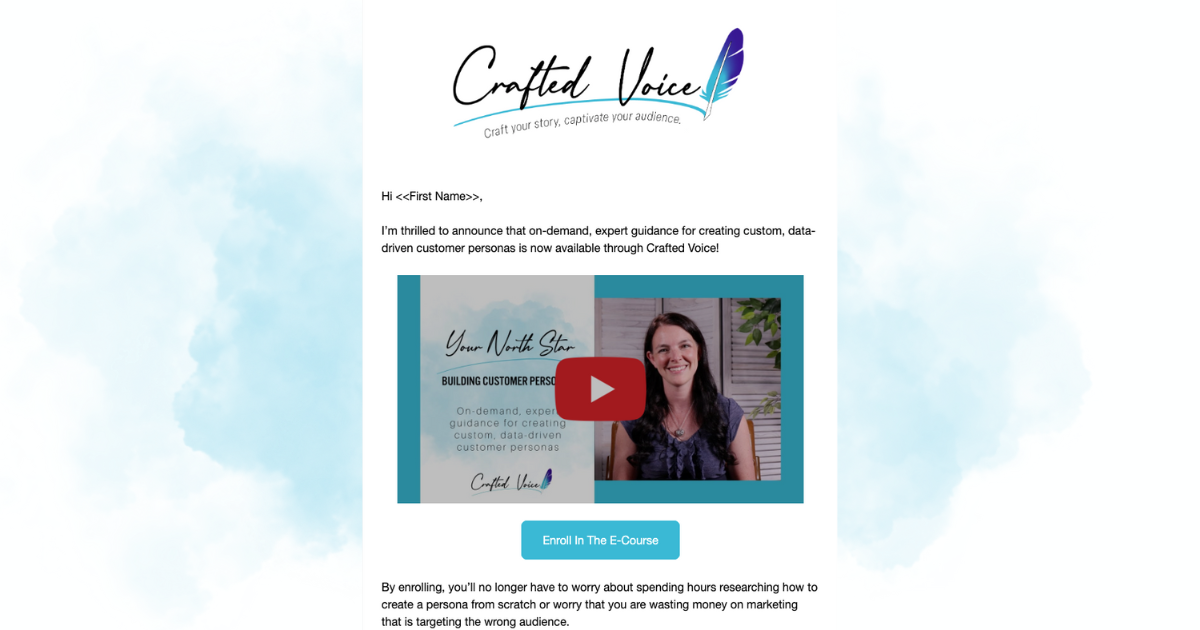
3. Website and SEO marketing
Your website is an example of “owned media” that allows you to tell your story and shine light on the value you can add to your target audience’s life by helping them solve their problem. At Crafted Voice, we base our SEO strategy on Pillar-Based Marketing (PBM), which builds a structured content network on our website to gain organic traffic.
PBM involves creating comprehensive, high-quality content around key topics (pillars) that are central to your business. Each pillar is supported by clusters of related content that link back to the main pillar page. This structure not only helps organize your content but also signals to search engines that your site is an authority on these topics, improving your chances of ranking higher in search results.
Here is how our Pillar content is presented on our website, which provides valuable content to our target audience:
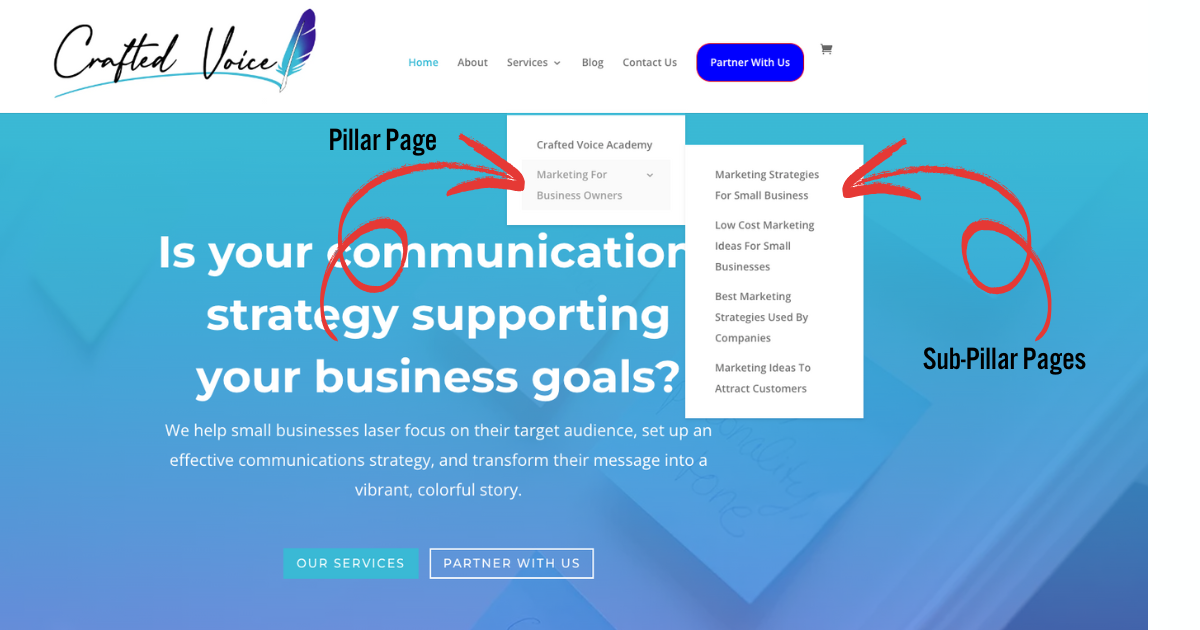
One Pillar on our website is Marketing for Business Owners. (Another Pillar page is the one you are reading right now!)
We have four Sub-Pillars that fall under “Marketing For Business Owners”:
- Marketing Strategies for Small Business
- Low Cost Marketing Ideas For Small Businesses
- Best Marketing Strategies Used By Companies
- Marketing Ideas To Attract Customers
And then there are 3 blogs for the Pillar and each of the Sub-Pillars, for a total of 12 blogs. You can browse our blog feed for even more helpful marketing resources and tips to grow your business.
Our team recommends that all small businesses consider Pillar-Based Marketing because it:
- Improves SEO: By organizing content around pillars, your website becomes more cohesive and easier for search engines to index, leading to better rankings.
- Establishes Authority: A well-executed pillar strategy positions your business as a thought leader in your industry, building trust with both search engines and potential customers.
- Enhances User Experience: Pillar-based content is logically organized, making it easier for visitors to navigate your site and find the information they need, which can lead to higher engagement and conversion rates.
- Provides Long-Term ROI: Unlike some short-term marketing tactics, pillar-based marketing is a sustainable approach that can continue to drive organic traffic and leads over time.
For small businesses, this strategy offers a cost-effective way to compete with larger players in your industry by focusing on niche topics that resonate with your target audience.
4. Advertising
Ads can be a slippery slope for small businesses if not done carefully and strategically. Depending on the platform you use, ads can be expensive, but they can also successfully put your business in front of your target audience quickly and easily.
Ads can be run on all social media platforms, Google, Yelp, newspapers, radio, TV, direct mail, billboards, and many more.
If you are considering running ads for your small business, start with your target audience to decide where to place your ads. For example, don’t run an ad on LinkedIn if your target audience isn’t on LinkedIn! From there, look at your business goals, your budget, and your timeline. All of these factors should be taken into consideration before you put together an ad strategy. We also recommend partnering with a professional who specializes in ad management to ensure you are setting your ads up for success.
What marketing resources are best for your business?
There are many marketing resources out there – how do you know which are best for your business? Don’t make strategic communications and marketing decisions that affect your business without consulting an experienced professional. Crafted Voice offers Strategic Communications and Marketing Business Coaching that offers expert guidance and data-driven insights for unstoppable business growth. With our coaching, you’ll have a trusted partner by your side, supporting you exactly where and when you need it.
Reach Us
We’re proud to serve business owners where we call home in the greater Columbus, Ohio metropolitan area. We also serve clients from coast-to-coast.
Together, let’s craft your story and captivate your audience!
Hilliard, Ohio
